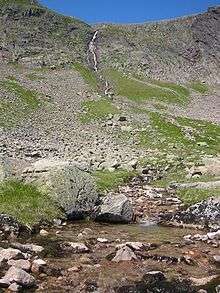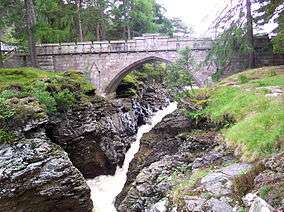River Dee, Aberdeenshire
| River Dee (Uisge Dhè) | |
| River | |
 The River Dee at Potarch, between Aboyne and Banchory. | |
| Country | Scotland |
|---|---|
| County | Aberdeenshire |
| Source | |
| - location | Wells of Dee, Braeriach, Cairngorms |
| - elevation | 1,220 m (4,003 ft) |
| Mouth | |
| - location | Aberdeen |
| Length | 140 km (87 mi) |
| Basin | 2,100 km2 (811 sq mi) |
| Notes:[1] | |
The River Dee (Scottish Gaelic: Uisge Dhè) is a river in Aberdeenshire, Scotland. It rises in the Cairngorms and flows through Strathdee to reach the North Sea at Aberdeen. The general area is called Strathdee, Deeside, or "Royal Deeside" in the region between Braemar and Banchory because Queen Victoria came to love the place and built Balmoral Castle there. The name is attested as early as the second century AD in the work of the Alexandrian geographer Claudius Ptolemy, as Δηοῦα (=Deva), meaning 'Goddess', indicating a divine status for the river in the beliefs of the ancient inhabitants of the area. The several other rivers of the same name in Great Britain have the same origin as has the Dee's near neighbour to the north, the River Don.
Geography
Upper reaches

The River Dee rises at approximately 4,000 feet in elevation on the plateau of Braeriach in the Cairngorm Mountains, the highest source of any major river in the British Isles.[1] Emerging in a number of pools called the Wells of Dee the young Dee then flows across the plateau to the cliff edge from where the Falls of Dee plunge into An Garbh Choire. The river is then joined by a tributary coming from the Pools of Dee in the Lairig Ghru and then flows south down the Lairig Ghru between Ben Macdui and Cairn Toul, tumbling over falls in the Chest of Dee on its way to White Bridge and the confluence with the Geldie Burn.
Linn of Dee


At Linn of Dee the river passes east through a 300-metre natural rock gorge. Between there and Braemar, Lui Water (formed by Luibeg and Derry burns) and Quoich Water join the growing River Dee. The River Clunie enters the Dee at Braemar.
Strathdee
Through Strathdee ("Deeside"; Scottish Gaelic Srath Dhè), the river passes Braemar, Balmoral Castle, Ballater, Dinnet, Aboyne and Banchory to reach the sea at Aberdeen. Near Ballater two rivers are tributaries – the River Gairn flowing from the north and the River Muick, flowing out of Loch Muick, from the south. The river is in the Cairngorms National Park until it reaches Dinnett. Water of Tanar flows through Glen Tanar before joining at Aboyne. The Water of Feugh has its confluence with the Dee at Banchory and Coy Burn enters at Milton of Crathes.
The tidal limit is just above Bridge of Dee, built about 1720, which carries the main A90 trunk road from Aberdeen to the south.[2] Before reaching the North Sea, the river passes through Aberdeen Harbour, the principal marine centre for the energy industry in Europe, servicing the offshore oil and gas industry.[3] An artificial channel was constructed in 1872 to straighten the river's flow into the sea. Footdee ("Fittie") is an old fishing village at the east end of Aberdeen Harbour.
Road and rail in the strath
The A93 road runs west along the north bank of the river from Aberdeen to Braemar before it turns south, leaving Strathdee, to climb to the Glenshee Ski Centre at Cairnwell Pass and then onwards to Perth. Just west of Ballater the A939 Lecht Road leaves the A93 to take a tortuous climb towards the Lecht Ski Centre then on to Tomintoul and eventually Nairn. West and north from Braemar there are no paved roads into the Cairngorms except for a narrow road which reaches Linn of Dee and doubles back to terminate at Linn of Quioch. Until 1966 the Deeside Railway ran from Aberdeen to Ballater and a very short section, the Royal Deeside Railway, has been restored as a heritage railway.
Natural history

The Dee is important for nature conservation and the area has many designated sites.[1] The upper catchment is within the Cairngorms National Nature Reserve and (since 2003) Cairngorms National Park. Much of the semi-natural Caledonian pine forest in Scotland is within the Dee catchment. The area contains nationally rare examples of pine woods, birch woods and heather moors with associated wildlife. On the valley floor there are deciduous alder and mixed broadleaved woods, and meadow grasslands. Otter, Water Vole and freshwater mussel are among the animal species under threat.
The Dee is a popular salmon river, having a succession of varied pools, intersected by sharp rapids. In 1995 it was estimated that salmon fishing on the river contributed between £5 and £6 million a year to the Grampian Region economy.[4]
Royal Deeside

The area around Braemar and Ballater is known as Royal Deeside by some people, and that usage had been encouraged by the tourist trade. Since the reign of Queen Victoria the British Royal Family have spent their summers at Balmoral Castle. Every year they attend the Braemar Highland Gathering and other local events.[5] Birkhall, previously owned by Queen Elizabeth the Queen Mother, is now a favourite retreat of Prince Charles.[6]
Gallery
 Wells of Dee on Braeriach
Wells of Dee on Braeriach Cairn Toul & Ben Macdui
Cairn Toul & Ben Macdui
References
- 1 2 3 Scottish Environment Protection Agency and www.theriverdee.org (2007). "The River Dee Catchment Management Plan: Issues Consultation Document" (pdf). Retrieved 9 March 2011.
- ↑ Stapleton, C.; Pethick, J. (1996). Review 52. Coastal processes and management of the Scottish Estuaries. III. The Dee, Don and Ythan Estuaries. (PDF). Scottish Natural Heritage. p. 19.
- ↑ "Aberdeen Harbour". Aberdeen Harbour Board. Retrieved 9 November 2013.
- ↑ Scottish Office (1997). Report of the Scottish Salmon Strategy Task Force. Edinburgh: Scottish Office.
- ↑ "The Queen, Prince Philip and Prince Charles attend the Braemar Gathering". News: NE Scotland, Orkney & Shetland. BBC. Retrieved 9 November 2013.
- ↑ Grice, Elizabeth (9 April 2005). "Alone at last (with just a few house guests)". Telegraph. Retrieved 9 November 2013.
External links
| Wikimedia Commons has media related to River Dee, Aberdeenshire. |
- River Dee Catchment Partnership Website
- Panorama of the Linn of Dee (QuickTime required)
- Visit Banchory Gateway to Royal Deeside
- Banchory Community Website
- Images of Tullich, Ballater & Crathie, Royal Deeside
- Royal Deeside and the Cairngorms tourism website
- Royal Deeside in the Cairngorms Park - Info and Accommodation site
- Exclusive images of Royal Deeside & a tad beyond
Coordinates: 57°4′18″N 2°51′0″W / 57.07167°N 2.85000°W
